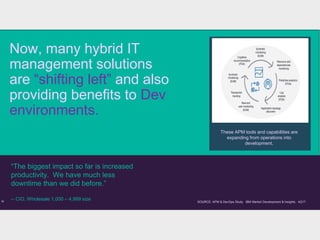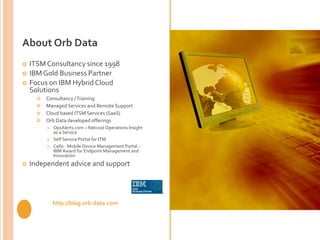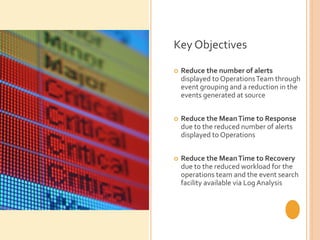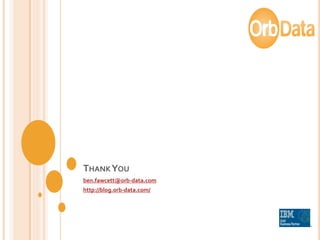Learn Best Practices of a True Hybrid IT Management Approach
- 1. IT & DATA MANAGEMENT RESEARCH, INDUSTRY ANALYSIS & CONSULTING Best Practices for Hybrid IT Management Julie Craig Research Director, Application Management Enterprise Management Associates Ben Fawcett CTO Orb Data Rob Lamb VP, Hybrid Cloud IBM
- 2. IT & DATA MANAGEMENT RESEARCH, INDUSTRY ANALYSIS & CONSULTING© 2016, Enterprise Management Associates Check out the on-demand webinar Get all the details! Watch the on-demand webinar! http://bit.ly/2yMSwXS 2
- 3. IT & DATA MANAGEMENT RESEARCH, INDUSTRY ANALYSIS & CONSULTING3 © 2017 Enterprise Management Associates, Inc. Featured Speakers Julie Craig, Research Director, EMA Julie has over 20 years of experience in software engineering, IT infrastructure engineering, and enterprise management. At EMA, Julie’s focus areas include DevOps, application performance and availability management, Application Discovery and Dependency Mapping, software development, and software as a service. Rob Lamb, VP, Hybrid Cloud, IBM Rob is a seasoned senior technology executive who has held leading positions in software development, sales, marketing, and business development in North America and Europe. Currently, Rob leads the strategy, offering management, and development of IBM's Hybrid Cloud Management portfolio. Ben Fawcett, CTO, Orb Data In his role as CTO at Orb Data, Ben is responsible for Orb Data’s software solution program, developing off-the-shelf and bespoke solutions in IT Service Management. Ben also works as a Lead Consultant for Orb Data and has over 18 years of experience providing strategy, architecture, development and implementation services in a range of Enterprise Management products, particularly in the IBM Hybrid Cloud portfolio.
- 4. IT & DATA MANAGEMENT RESEARCH, INDUSTRY ANALYSIS & CONSULTING4 © 2017 Enterprise Management Associates, Inc. Logistics An archived version of the event recording will be available at www.enterprisemanagement.com • Log questions in the chat panel located on the lower left-hand corner of your screen • Questions will be addressed during the Q&A session of the event QUESTIONS EVENT RECORDING A PDF of the speaker slides will be distributed to all attendees PDF SLIDES
- 5. IT & DATA MANAGEMENT RESEARCH, INDUSTRY ANALYSIS & CONSULTING Best Practices for Hybrid IT Management Julie Craig Research Director, Application Management Enterprise Management Associates
- 6. IT & DATA MANAGEMENT RESEARCH, INDUSTRY ANALYSIS & CONSULTING© 2017 Enterprise Management Associates, Inc. Agenda • Hybrid Architectures and Ecosystems • Service Delivery Challenges in a Hybrid World • Automation for Service Delivery and the Role of Analytics • Navigating the Hybrid Shift 6
- 7. IT & DATA MANAGEMENT RESEARCH, INDUSTRY ANALYSIS & CONSULTING One “flavor” of Hybrid IT 7 © 2017 Enterprise Management Associates, Inc. Hybrid IT The connection of one or more clouds to on-premises systems and/or the connection of one or more public or private clouds to other clouds. Successful hybrid deployments deliver: ‒ Platform choice ‒ Integration and portability ‒ Data and analytics ‒ Visibility, control and security On-Premises IT Public Dedicated and Local Private
- 8. IT & DATA MANAGEMENT RESEARCH, INDUSTRY ANALYSIS & CONSULTING % Of Companies Running Hybrid Transactions Spanning On- prem And External Services Has Grown By 31% In Past 2 Years 8 © 2017 Enterprise Management Associates, Inc. Is your organization running "hybrid" transactions that share data and/or functionality between externally hosted applications (public cloud or outsourced) and in-house delivered applications? 68% 26% 6% Yes No Don't know 2017 2015
- 9. IT & DATA MANAGEMENT RESEARCH, INDUSTRY ANALYSIS & CONSULTING© 2017 Enterprise Management Associates, Inc.9 Agenda • Hybrid Architectures and Ecosystems • Service Delivery Challenges in a Hybrid World • Automation for Service Delivery and the Role of Analytics • Navigating the Hybrid Shift
- 10. IT & DATA MANAGEMENT RESEARCH, INDUSTRY ANALYSIS & CONSULTING Challenge #1: Filling Instrumentation Gaps: APIs, WAN Provider, Internet, Cloud Response Time, etc. 10 © 2015 Enterprise Management Associates, Inc. Which types of external services are the primary types you are connecting TO (consuming)? 46% 44% 39% 39% 35% 33% 9% Customer-provided services Software as a Service (SaaS) Supplier-provided services Partner-provided services Infrastructure as a Service (IaaS) Platform as a Service (PaaS) Open-source sites and assets “Hybrid” almost synonymous with “connected”. How well do your tools support integration points?
- 11. IT & DATA MANAGEMENT RESEARCH, INDUSTRY ANALYSIS & CONSULTING Challenge #2: Evolving From Silo Based To Cross-functional Support Teams And Tools 11 © 2017 Enterprise Management Associates, Inc. Sample Size = 201 What is the primary way in which your IT teams diagnose and solve application-related problems that occur in production environments? 27% 23% 21% 18% 10% Troubleshooting primarily supported by domain experts (such as windows admins, DBAs, etc.) using silo tools Troubleshooting primarily supported by DevOps teams (or cross- functionally trained personnel) using silo tools Troubleshooting primarily supported by "war room" meetings Troubleshooting primarily supported by DevOps teams (or cross- functionally trained personnel) using on-premise hosted Application Management or Application Performance Management (APM) toolsets Troubleshooting primarily supported by DevOps teams (or cross- functionally trained personnel) using Cloud hosted Application Management or Application Performance Management (APM) toolsets
- 12. IT & DATA MANAGEMENT RESEARCH, INDUSTRY ANALYSIS & CONSULTING© 2017 Enterprise Management Associates, Inc. Additional Hybrid IT Challenges • Provisioning diverse platforms – Each platform and cloud service has unique provisioning requirements and consumption models • User self service – Taking IT out of the equation by providing self-service provisioning options for Development and Test teams • Deploying and supporting integrations – APIs, MQ, cloud-based integration connect diverse components and platforms into transactions • Multi-cloud decision-making, inter-cloud governance – Determining the “right” cloud option for a given workload, governance policies related to each platform type, etc. • Orchestrating development and support of hybrid services – Development, DevOps/Continuous Delivery practices and tools addressing cross-functional support • Re-tooling for Hybrid IT Performance and Availability Management – Advanced analytics supporting IT personnel in delivering complex apps 12
- 13. IT & DATA MANAGEMENT RESEARCH, INDUSTRY ANALYSIS & CONSULTING© 2017 Enterprise Management Associates, Inc.13 Agenda • Hybrid Architectures and Ecosystems • Service Delivery Challenges in a Hybrid World • Automation for Service Delivery and the Role of Analytics • Navigating the Hybrid Shift
- 14. IT & DATA MANAGEMENT RESEARCH, INDUSTRY ANALYSIS & CONSULTING© 2016, Enterprise Management Associates Two Types Of Tools-related “Hybridization” • Data integration consolidating and sharing metrics from diverse toolsets across the application lifecycle – Day to day support for all aspects of hybrid IT via sharing of artifacts from diverse IT monitoring and management tools • Supports evolution from silo-focused to cross functionally-focused IT support practices • Supports cross-functional support and DevOps functions • Integrations and analytics supporting a unified view to hybrid IT environments – Delivers an integrated view into the end to end hybrid service – Correlation/analysis of metrics generated by diverse instrumentation systems (infrastructure/app monitoring, UEM, API, etc.) via an analytics overlay • This design maximizes the value proposition of existing tools investments while moving IT support practices into the future 14
- 15. IT & DATA MANAGEMENT RESEARCH, INDUSTRY ANALYSIS & CONSULTING Automating The Lifecycle: Sharing Artifacts Produced At Each Stage With Subsequent Stages 15 © 2016, Enterprise Management Associates Stage Roles Tools Design Lead Roles: Development. LOB Stakeholders Participants: Ops ALM Requirements Management Modeling Project Management Develop Lead Roles: Development. Participants: LOB Stakeholders, Ops IDEs Debug Repository Error Scan Build Automation Test Lead Roles: Development/QA, Ops Participants: LOB Stakeholders Test Management Test Data Management API Test Integration Test (Service Virtualization) Deploy/ Release Lead Roles: Development, Ops Participants: LOB Stakeholders Process Orchestration Configuration Management Release Automation Manage Lead Roles: Ops Participants: Development, LOB Stakeholders Run Book Automation Systems Management Application Management Performance/Availability Mgt User Experience Management Service Desk/Trouble Ticket Assess Lead Roles: LOB Stakeholders Participants: Development, Ops Service Level Management
- 16. IT & DATA MANAGEMENT RESEARCH, INDUSTRY ANALYSIS & CONSULTING© 2016, Enterprise Management Associates But Data Alone Is Not Enough; Analytics Increasingly Important To Management Of Complex Applications 16 A cohesive hybrid IT management platform Automation umbrella/overlay correlates from underlying tools, delivering single pane of glass into hybrid environments
- 17. IT & DATA MANAGEMENT RESEARCH, INDUSTRY ANALYSIS & CONSULTING© 2017 Enterprise Management Associates, Inc.17 Agenda • Hybrid Architectures and Ecosystems • Service Delivery Challenges in a Hybrid World • Automation for Service Delivery and the Role of Analytics • Navigating the Hybrid Shift
- 18. IT & DATA MANAGEMENT RESEARCH, INDUSTRY ANALYSIS & CONSULTING© 2017 Enterprise Management Associates, Inc. Recommendations • Vision: A consolidated “top down” approach to hybrid management consisting of an intelligent operational analytics overlay consolidating disparate platforms into one operational model • Steps: – Complete an assessment and gap analysis of tools supporting IT infrastructure, network, and application management – Re-evaluate performance of cross-platform integrations and network connections that can seriously impact application performance/availability – Identify gaps and requirements for near term future – Deploy tools addressing current gaps, focusing on both on- premises and off-premises systems – Develop a strategy for integrating current metrics/instrumentation by adding an intelligent analytics overlay – Plan for the “next steps” required for further management automation 18
- 19. July, 2017 Integrate, Automate, Innovate Solutions for a hybrid IT management strategy
- 20. 20 say a hybrid IT management strategy helps get new apps into market faster. 69% The right set of hybrid IT management solutions lead to better customer experience and competitive advantage. APPLICATIONS & SERVICES Deliver them faster and with higher availability, reliability and performance MULTI-CLOUD ENVIRONMENTS Seamlessly connect and manage private, public, and multi-cloud environments IT INFRASTRUCTURE Infuse analytics into IT operations management solutions – proactive vs. reactive SOURCE: IBM Market Development & Insights Market Research, 2017
- 21. Better manage your hybrid IT environment. IT infrastructure performance Look for a mature suite of solutions that let you identify and resolve problems faster and contain embedded analytics for true insights. Application performance Look for solutions that not only allow you to get apps into market faster, but also help you ensure their availability and performance.
- 22. 22 Better manage your hybrid IT environment. IT infrastructure performance Look for a mature suite of solutions that let you identify and resolve problems faster and contain embedded analytics for true insights. Application services The right application server solutions will let you create, connect and optimize your apps wherever they are to help you increase your speed to market and reduce costs. Multi-cloud connectivity There are now solutions to help you get clear visibility into multi-cloud environments and provision, orchestrate and define policies from a single console. Application performance Look for solutions that not only allow you to get apps into market faster, but also help you ensure their availability and performance.
- 23. 23 IBM’s suite of hybrid IT management solutions can help you integrate, automate and innovate. IT infrastructure performance Netcool Operations Insight solutions will let you better monitor and manage your IT operations environments with integrated tools, correlated data, and embedded analytics. Application services WebSphere Application Server, coupled with new offering around microservices, enables simple and seamless migration of existing applications to the cloud as well as ease of creating and deploying “net-new” apps. Multi-cloud connectivity IBM Cloud private with cloud automation features allows you to keep mission-critical apps secure while still enabling connectivity to other public or private clouds so you can manage true multi-cloud environments in an automated way. Application performance Application Performance Management (APM) solutions give you the right set of tools to diagnose and resolve application issues faster and more accurately – even predict them before they occur.
- 24. 24 The rate and pace of adoption is based on a company’s needs. What’s important to remember is a hybrid IT management strategy is not an “all or nothing” approach.
- 25. Let’s look at a few examples of companies already embarking on our hybrid IT management strategy Integration between IBM hybrid IT management products reduced their outage times, and improved identification of issues before they became problems. Through IBM multi-cloud provisioning as an integrated part of their hybrid IT management strategy, they have improved deployment accuracy of applications using less resources Growing customer engagement and sales with IBM Cloud based microservices build on WebSphere, as an integrated part of their IT hybrid management solution. 4
- 26. 26 Now, many hybrid IT management solutions are “shifting left” and also providing benefits to Dev environments. SOURCE: APM & DevOps Study. IBM Market Development & Insights. 4Q17 These APM tools and capabilities are expanding from operations into development. “The biggest impact so far is increased productivity. We have much less downtime than we did before.” -- CIO, Wholesale 1,000 – 4,999 size
- 27. 27 For more information and getting started, IBM can help: Visit us at: www.ibm.com/cloud-computing/products/hybrid-it-management/ Call us at: 1-844-95-CLOUD (Priority code: CLOUD)
- 28. LEARN BEST PRACTICES OF A TRUE HYBRID IT MANAGEMENT APPROACH Ben Fawcett CTO, Orb Data
- 29. About Orb Data ITSM Consultancy since 1998 IBM Gold Business Partner Focus on IBM Hybrid Cloud Solutions Consultancy /Training Managed Services and Remote Support Cloud based ITSM Services (SaaS) Orb Data developed offerings OpsAlerts.com – Netcool Operations Insight as a Service Self Service Portal for ITM Cello - Mobile Device Management Portal – IBM Award for Endpoint Management and Innovation Independent advice and support http://blog.orb-data.com
- 30. 30 HOW ARE RECENT TRENDS IMPACTING ITSM DEPARTMENTS? IT consumers are becoming more demanding User experience On-demand Self-service and in control Access to their own SaaS Business applications are more dynamic Virtualisation Composite applications Containers DevOps Now!
- 31. 31 HOW ARE RECENT TRENDS IMPACTING ITSM DEPARTMENTS? Application Performance Management (APM) has become a Big Data problem Metric collection Logfile analysis Event trends Business expectations are rising Automation – deployment, detection and remediation Analytics Business Service mapping, measuring and visualising
- 32. 32 FUNDAMENTALS OF ITSM The ITSM landscape and tooling are changing but many fundamentals are not Understand what you have and empower the IT users to understand it Unify the tooling and standardise your approach and methodology Improve efficiency and automate repeatable tasks Develop an Overall StrategicVision that embraces hybrid and is appropriate for your organisation Self-Service -> Empower and Devolve Service Catalogue -> Standardise and Automate Exploit analytics -> Predict, Reduce and Improve DevOps initiatives -> Unified approach to ITSM
- 33. 33 PRACTICAL AND TACTICAL Realising a strategic vision doesn’t happen overnight What practical steps can you take to prepare for managing complex Hybrid Services? Some examples of recent Orb Data client projects 1. Unifying data across the cloud - Global Bank Public SaaS Service Desk and CMDB, on-premises IT Operations and Capacity Management 2. Using Operations Analytics - LargeTelco Using analytics to improve IT Operations efficiencies 3. User Driven Deployment - Financial Services Using self-service as a model to empower users, devolve responsibility, enforce standards and automate deployment 4. Shift left… and right? We’re all developers A word on DevOps and how ITSM teams should respond
- 34. Unifying data across the cloud - Global Bank SaaS Service Desk Business applications on-premises and hybrid Unifying Data for: ServiceViews Event Enrichment Capacity Planning
- 35. 35 SOLUTION OVERVIEW Public Cloud SaaS Service Desk Data Warehouse IBM DASH IBM Netcool OMNIbus IBM Netcool ImpactCMDB Tivoli Common Reporting Topology IBM Application Performance Montoring Severity Modelling Enrichment Events Impact UI Data Provider Data Merge Performance Metrics Events Auto-ticketing Incidents
- 36. 36 ENRICHMENT Server Service Application Component ukepd01 Payments EasyPay Database ukepd02 Payments EasyPay Database ukepweb01 Payments EasyPay Web ukfsftp01 Payments FileSafe FTP
- 37. 37 TOPOLOGY Item Topology ID Topology Parent ID Layer Payments 0 - 1 EasyPay 1 0 2 Database 2 1 3 ukepdb01 3 2 4 ukepdb02 4 2 4 Web 5 1 3 ukepweb01 6 5 4
- 38. 38 SEVERITY CALCULATION Active and inactive handling for resilient resources A rules table to apply a severity multiplier to particular events A weighting for each child node in the tree Various severity models to choose for each node - including maximum, average and weighted average
- 40. Operations Analytics at a LargeTelco LargeTelecoms business Managed Service division IT Event Management service for customers Individual Netcool environments to serve each customer Upgrade to Netcool Operations Insight to exploit the OperationsAnalytics capabilities
- 41. Key Objectives Reduce the number of alerts displayed to OperationsTeam through event grouping and a reduction in the events generated at source Reduce the MeanTime to Response due to the reduced number of alerts displayed to Operations Reduce the MeanTime to Recovery due to the reduced workload for the operations team and the event search facility available via Log Analysis
- 42. 42 WHAT DID WE DO? 1. Conducted Regular review of event grouping analysis reports 2. Built new light weight dashboards 3. Implemented Log Analysis event search facility to aid with problem determination 4. Conducted Regular review of seasonality reports 5. Engaged Subject Matter Experts to define Event Scoping 6. And retrained the operators
- 43. 43 RELATED EVENT STATISTICS 14806 events reduced to 759 95% efficiency Average group Size 10595 events covered by top 100 groups Top group size Average group Size
- 44. 44 IT OPERATIONS EFFICIENCY Pre-Occurrence Incident ResolutionEvent Time 0 Event Count Event Search Related Event Analytics Seasonal Analytics Service Desk Integration Event Scope Grouping Dashboards Historical Event Analysis Maintenance Management Message Catalogue
- 45. 45 OPSALERTS FROM ORB DATA IBM Netcool Operations Insight as a Service - Event management in the cloud Built on IBM Bluemix Real-time event analytics Health dashboards Message Catalogue Maintenance Management Service Desk integration
- 46. 46 BENEFITTING FROM CLOUD AND DEVOPSTRENDS SaaS applications are available to ITSM teams too IBM Alert Notifications IBM RunbookAutomation Website monitoring Orb Data OpsAlerts : IBM Netcool Operations Insight as a Service Shift Left? But what ideas should ITSM learn from Development? Source control and Release Management API management and integration Focus on User Experience Automated testing Service definitions and automated provisioning of ITSM














































